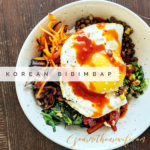For those who know me well, you know how much I love Asian food. I also love food in bowls. Rice bowls, noodle bowls, buddha bowls, soup in bowls, salad in bowls. You get the drift. There’s just something about a mishmash of items that brings out my inner granny. So as you can imagine, when I come across a dish like bibimbap…I’m obviously going to fall head over heels.
According to the internets, the name for this Korean dish is translated with the term “bibim” meaning mixing various ingredients, while the “bap” part refers to rice. Traditionally, bibimbap is warm white rice topped with sautéed vegetables and a chili pepper paste. It’s often topped with a fried egg and meat.
Over the years, I’ve iterated and served my bibimbap in many different variations. In addition to the veggies, I’ve used beef, bacon, chicken and tofu. Most recently, I converted my bulgogi recipe to use lentils in lieu of beef, and it’s my favourite yet. Because of this, I’m re-posting this recipe for you (but feel free to stick to meat if that’s what floats your boat!)
The secret to bibimbap is no secret at all: just use whatever vegetables you have on hand. Onions, garlic, spinach, mushrooms, carrots, bok choy, scallions, peppers, zucchini, sprouts, asparagus, corn, tomatoes, etc. If you have it, use it.
The traditional sauce served with bibimbap is Gochujang, made with a Korean chili pepper paste, which can be found at most Asian food stores. However, other variations include topping with a mixture of sesame oil, red wine vinegar, and some type of hot sauce like Sriracha. I’d highly recommend making the effort to find the Gochujang, because it definitely makes a difference in taste, but if you’re REALLY strapped for time, PC brand carries a bottle of prepared sauce called “Memories of Seoul” that serves as a great stand in. A runny egg yolk is a great addition to this recipe because it helps contribute to the sauce, but it can easily be ommitted for a plant-based meal.
Another variation is to serve it in a hot stone bowl coated with sesame oil. When the rice is added, the bottom layer becomes crispy and golden brown.
Now I just need to invest in some stone bowls…
Sauce recipe courtesy of My Korean Kitchen.

Korean Bibimbap
Ingredients
Gochujang Sauce:
- 2 tbsp Gochujang paste can be found in Korean grocery stores
- 1 tbsp sesame oil
- 1 tbsp sugar
- 1 tbsp water
- 1 tbsp toasted sesame seeds
- 1 tsp apple cider vinegar
- 2 cloves garlic minced
Lentil "Bulgogi":
- 1 tsp olive oil
- 2 cloves garlic minced
- 1 19 oz can lentils drained and rinsed
- 2-4 tsp soy sauce
- 1-4 tsp sugar
- 1-3 tsp sesame oil
- 1 tbsp chopped green onion
- 1 tsp sesame seeds
- freshly ground pepper
- 1-2 tbsp water optional, if you like it saucier or need to tone down the flavours
Bibimbap:
- 4 cups cooked rice Jasmine, brown, etc.
- olive or sesame oil for sautéeing
- 2 cups packed fresh spinach
- 1 cup sliced mushrooms
- 1 carrot peeled and julienned
- ½ bell pepper julienned
- 1 small zucchini julienned
- 4 green onions sliced
Eggs:
- 4 tsp olive oil
- 4 eggs
- freshly ground salt & pepper to taste
Instructions
Gochujang Sauce:
- In a small bowl, mix together Gochujang paste, 1 tbsp sesame oil, 1 tbsp sugar, 1 tbsp water, 1 tbsp toasted sesame seeds, apple cider vinegar and 2 cloves garlic, minced. Set aside.
Lentil Bulgogi:
- Heat 1 tsp olive oil in a medium skillet over medium heat. Add 2 cloves minced garlic and cook until fragrant, about 1 minute. Add lentils, 2-4 tsp soy sauce, 1-4 tsp sugar, 1-3 tsp sesame oil, 1 tbsp chopped green onion and 1 tsp sesame seed. Season to taste with pepper. Add water if desired. Mix together well and remove from heat. Keep warm.
Bibimbap:
- Heat a small skillet over medium-high heat and add a little oil. Sauté each of the vegetables separately, adding a little sesame oil each time and seasoning to taste with salt and pepper. Remove and keep warm, but separate.
Eggs:
- Meanwhile, add 4 tsp olive oil to a medium sized skillet and heat over medium-low heat. Add eggs to pan. Cook until the tops of the whites are set, but the yolks are still runny.
Assemble:
- Divide rice between two bowls. Place mushrooms, spinach, lentils, carrot, zucchini, sprouts and bell pepper around on top of the rice, alternating colours. Top with eggs and season with salt and pepper. Serve with Gochujang sauce.
The post Bibimbap appeared first on The Gourmet Housewife.

